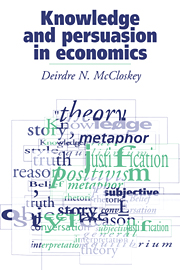Book contents
- Frontmatter
- Contents
- List of figures and tables
- Preface
- Acknowledgments
- Part I Exordium
- Part II Narration
- Part III Division
- Part IV Proof
- 9 The rise of a scientistic style
- 10 The rhetoric of mathematical formalism: existence theorems
- 11 General equilibrium and the rhetorical history of formalism
- 12 Blackboard Marxism
- 13 Formalists as poets and politicians
- Part V Refutation
- Part VI Peroration
- List of works cited
- Index
10 - The rhetoric of mathematical formalism: existence theorems
Published online by Cambridge University Press: 01 February 2010
- Frontmatter
- Contents
- List of figures and tables
- Preface
- Acknowledgments
- Part I Exordium
- Part II Narration
- Part III Division
- Part IV Proof
- 9 The rise of a scientistic style
- 10 The rhetoric of mathematical formalism: existence theorems
- 11 General equilibrium and the rhetorical history of formalism
- 12 Blackboard Marxism
- 13 Formalists as poets and politicians
- Part V Refutation
- Part VI Peroration
- List of works cited
- Index
Summary
The main figure of economic rhetoric has become the conspicuous use of mathematics. The rise of a scientistic style in economics has been accompanied by the rise of mathematical formalism. In 1972 Benjamin Ward identified a “formalist revolution” beginning in the 1940s (Ward 1972, p. 40). Philip Mirowski has recently dated what he calls “the second rupture” in mathematical rhetoric to the 1930s, attributable he argues to a belief by young physicists and other scientists that economic problems urgently needed their skills (1991b, p. 151; compare the similar entry of physicists into biology after the Second World War). In 1986 Herbert Grubel and Lawrence Boland surveyed the results. From 1951 to 1978 the number of pages containing a mathematical expression without empirical use rose in the American Economic Review from 2.2 percent to 44 percent (Grubel and Boland, 1986, p. 42; cf. Debreu 1991, p. 1). The rise was matched in other high-prestige journals, accelerated by the birth of journals devoted entirely to such products. (The products have not pleased the customers. Grubel and Boland sampled several hundred economists of various types and found that over two-thirds believed that excessive space in the journals is devoted to purely theoretical articles [1986, p. 433]).
- Type
- Chapter
- Information
- Knowledge and Persuasion in Economics , pp. 127 - 145Publisher: Cambridge University PressPrint publication year: 1994



